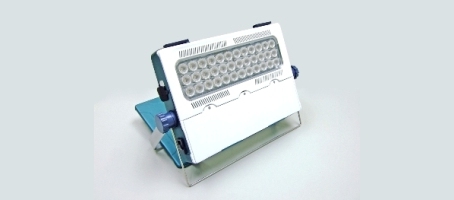Let's have some fun, shall we?

http://www.altuslumen.com/Ultra_Pro_led_light.html said:
ULTRA-PRO is the world's first 6,500 Lumen portable battery operated LED Light,
LIES! The DataBank 70, as saabluster mentioned, exceeds that.
http://www.altuslumen.com/Ultra_Pro_led_light.html said:
because of the latest LED technology, its 90W light source is as bright as the 500W halogen lamp.
Yeah, that's doable.
http://www.altuslumen.com/Ultra_Pro_led_light.html said:
Just because total weight is less than 5kg, size is as compact as a 15" portable computer, powered by rechargeable battery and water resistant design, ULTRA-PRO is a reliable light for outdoor operation in the darkness.
5kg is a little heavy for a portable computer (I suppose they mean a laptop), but I don't doubt their ability to measure mass properly.
http://www.altuslumen.com/Ultra_Pro_led_light.html said:
Cyclic
The main housing is made of recycled and recyclable aluminum and polycarbonate.
ULTRA-PRO is over 75% recyclable at the end of its useful life.
Okay.
http://www.altuslumen.com/Ultra_Pro_led_light.html said:
Efficient
LED is 500% more power efficient and 10 times more durable than halogen lamp.
Once again, doable.
http://www.altuslumen.com/Ultra_Pro_led_light.html said:
Multiple level output, durable and water resistance construction gives longer utility to the user and reduce the need for the new.
Okay.
http://www.altuslumen.com/Ultra_Pro_led_light.html said:
Safe
LED contains no mercury or toxic heavy metal.
Very true.
http://www.altuslumen.com/Ultra_Pro_led_light.html said:
LED is cool light source and it is safe to touch.
LIES! Horrible lies! It's like they believed that Philips guy on "Manmade" who said that "with LEDs, there's no heat involved." Lies. Every device creates waste heat. "In this house, we obey the laws of thermodynamics!"
http://www.altuslumen.com/ultrapro_specifications.html said:
LED Type 2.5W High power LED x36pcs
Light Output 6500Lumen (Ultra Mode)
6500L/36LEDs=180L/LED: I don't know if that's out the front lumens or emitter lumens. Still, it's doable with reasonable bins.
180L/2.5W=72L/W: Yep, pretty reasonable.
http://www.altuslumen.com/ultrapro_specifications.html said:
Power Consumption 90W (Ultra Mode)
36W (Full Power Mode)
1W (Long Life Mode)
6500L/90W=72L/W: Again, assuming they used decent bins and are quoting emitter lumens, doable.
http://www.altuslumen.com/ultrapro_specifications.html said:
Power Source 10x D-size Alkaline primary batteries *
10x D-size NiMH rechargeable batteries, 9-10Ah/cell
AC/DC Power Adaptor >120W, 24V
12V or 24V Car Cigarette Power
90W/10 cells=9W/cell
9W/1.5V=6A
They say that 10D alks are okay for 90W? A fresh D alk will not stay at 1.5V for very long at 6A, if it can deliver that at all. I'd expect alk runtime on "Ultra" to be a small fraction of NiMH runtime.
http://www.altuslumen.com/ultrapro_specifications.html said:
Battery Powered Time ** 1.3hrs (Ultra Mode)
3.3hrs (Full Power Mode)
13.3hrs (Long Life Mode)
Yeah, 1.3 hours ON NIMHS ONLY (decent ones of at least 10Ah or so). With alks, you'd get maybe 10-20 minutes on "Ultra," if it can handle that level at all.
90W*1.3h=117Wh
36W*3.3h=118Wh
1W*13.3h=13.3Wh
Whoa, what's up with the "Long Life Mode" runtime? It should be closer to 117h, not 13h.
Well, other than some wrong-looking numbers, there were only two horrible lies. Could be worse, but I would still have major doubts until the output and runtime numbers (as well as regulation) were verified by an outside source.
Thanks for posting the link. Good times.






 :laughing:
:laughing: . I give you my word: There is no wayyyy that you could pull 6A from a Alkaline D:shakehead.
. I give you my word: There is no wayyyy that you could pull 6A from a Alkaline D:shakehead.